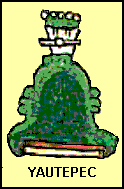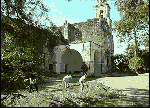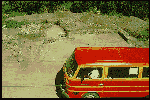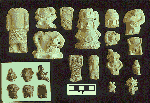
by Dr. Michael E. Smith
Professor of Anthropology, University at Albany, State University of
New York
Yautepec was an Aztec urban center
whose ruins today lie under the modern town of the same name in the
Mexican state of Morelos. Three recent archaeological projects make
Yautepec one of the most intensively-studied Aztec cities outside of
the imperial capital Tenochtitlan. First, Hortensia de Vega Nova of the
Centro INAH en Morelos (Instituto Nacional de Antropologia e Historia)
has been excavating the royal palace at Yautepec. Second, I directed
excavations of houses at Yautepec. Third, my students Lisa Cascio and
Timothy Hare conducted a regional survey of settelement patterns in the
Yautepec Valley. This web page describes some of the results of the
first two projects. Much of the text is adapted from my book, The
Aztecs (Blackwell Publishers, Oxford, 1996). All three
projects are ongoing, and there is still much to be learned about Aztec
Yautepec. The inhabitants of Yautepec were known as the Tlahuica, one
of the regional ethnic groups of Aztec civilization.
For more information about the book, THE AZTECS: Click
Here
Note: You may click on the small icon images to view
larger photographs of the excavations, architecture, and artifacts from
the Yautepec excavations. Then use your browser's "back" button to
return to the main document.

The Royal Palace of Yautepec
For many years archaeologists were aware of a large Aztec-period mound
at the edge of the modern town of Yautepec in Morelos, but none of us
had any idea of the importance of this structure. When the mound was
threatened by urban expansion in the 1980s, a local citizen's group
organized to help save it. A team of Mexican government archaeologists
began excavations at the mound in 1989, under the direction of
Hortensia de Vega Nova, and fieldwork has continued through 1996. The
excavators discovered an enormous stone platform some 6,000 square
meters in area (0.6 hectares, or about 1.5 acres) that had been the
royal palace of the king (tlatoani) of Yautepec. This is the first
Aztec royal palace to be excavated by archaeologists (see
photo).
Yautepec was a powerful polity whose king ruled over four or five
lesser city-states in the Yautepec river valley. The Aztec city of
Yautepec, located under and adjacent to modern Yautepec, was the
largest city in the area, and the sumptuous royal palace was of a size
befitting the power of the city's king. The outer walls of the
structure were sloping panels of stone four meters high that presented
an imposing image to the people of Yautepec. Entrance was by a single
stairway up the west side of the building, which led to a passageway
into the heart of the palace.
Excavations on top of the platform have uncovered numerous courtyards,
rooms, and passages, all constructed of stone covered with layers of
lime plaster. The palace walls were covered with elaborate polychrome
murals. There is evidence for several stages of construction at this
structure. To date, archaeologists have cleared only about one-quarter
of the palace. If there was a large central patio or courtyard, as at
other known Aztec palaces, it has not been found yet.

More information about the palace excavations can be
found in the Tlahuica Ruins Page



You may click on these photos of the Yautepec royal palace.
The Albany Excavations of Houses at Yautepec
 After the success of the initial seasons of Hortensia de Vega Nova's
excavations at the Yautepec royal palace, my wife (Cynthia Heath-Smith)
and I were invited by the Mexican government to work at Yautepec. The
palace was on the edge of the modern town with Aztec residential areas
extending into agricultural fields to the west and south. This left
major areas of Aztec Yautepec open for fieldwork. de Vega Nova
continued her work at the palace and we concentrated on excavating
houses and other features in other parts of the site. Although
fieldwork at the palace is still not completed, and our analyses of
artifacts are still in progress, the two complementary projects have
already uncovered much new information on Aztec urban life.7
After the success of the initial seasons of Hortensia de Vega Nova's
excavations at the Yautepec royal palace, my wife (Cynthia Heath-Smith)
and I were invited by the Mexican government to work at Yautepec. The
palace was on the edge of the modern town with Aztec residential areas
extending into agricultural fields to the west and south. This left
major areas of Aztec Yautepec open for fieldwork. de Vega Nova
continued her work at the palace and we concentrated on excavating
houses and other features in other parts of the site. Although
fieldwork at the palace is still not completed, and our analyses of
artifacts are still in progress, the two complementary projects have
already uncovered much new information on Aztec urban life.7
In our first season of fieldwork (1992), we used surface concentrations
of artifacts to trace the size and shape of the Aztec city. This was
easy in the plowed fields, but required patience and perseverance
within town. Our field crews spent a lot of time knocking on doors and
explaining our purpose to the people of Yautepec so that they would let
us root around in their yards for potsherds, obsidian, and other traces
of Aztec occupation. I was surprised at how well we were able to find
artifacts in and around modern Yautepec, and the goodwill of the
citizens contributed greatly to our success. We made several hundred
collections of artifacts from two by two meter squares and used
computer-generated maps of artifact density to help draw the borders of
Aztec Yautepec. The city reached its maximum extent, 210 hectares (2.1
square km), in the Late Aztec B period, just prior to the Spanish
conquest (AD 1430-1520). Although there were some earlier villages at
the site, the major occupation began in the Early Aztec period (AD
1100-1300), which suggests that Yautepec, like other Aztec cities, was
founded by immigrants from Aztlan.
 Our second season (1993) was devoted to excavations of houses, garbage
middens, and other key areas in and around Aztec Yautepec. We placed
excavations in various parts of the modern town, including schoolyards,
vacant lots, residential neighborhoods, churchyards (see photo
of excavations in the yard of the 16th century church).,
plowed fields, and even a street (see photo of an Aztec house
excavated at the edge of a street).. In all we placed
excavations in 17 different areas of Yautepec. Twelve of these 17
excavations were undertaken specifically to find buried houses. We
located and excavated seven Aztec houses as well as numerous other
domestic deposits.
Our second season (1993) was devoted to excavations of houses, garbage
middens, and other key areas in and around Aztec Yautepec. We placed
excavations in various parts of the modern town, including schoolyards,
vacant lots, residential neighborhoods, churchyards (see photo
of excavations in the yard of the 16th century church).,
plowed fields, and even a street (see photo of an Aztec house
excavated at the edge of a street).. In all we placed
excavations in 17 different areas of Yautepec. Twelve of these 17
excavations were undertaken specifically to find buried houses. We
located and excavated seven Aztec houses as well as numerous other
domestic deposits.
The locations of the excavations and houses are shown on the map of
Yautepec. We dug one elite residence (structure 6), five commoner
dwellings (structures 1-4 and 7), and one intermediate structure (no.
5). This is the first set of urban Aztec houses excavated anywhere in
central Mexico. We were somewhat surprised that the urban houses (see
chapter 6) were quite similar in size and construction to the rural
houses we had excavated previously at Cuexcomate and Capilco. (Click
here for information on the excavations of Aztec rural sites). The
population density of Yautepec was not much higher than the rural
sites, and this implies that this city had considerable open space for
gardens and fields within its borders.



You macy click on these photos of the 1993 Albany excavations at
Yautepec.
Preliminary results indicate that there may have been a
zone of wealthy residents to the west of the royal palace, perhaps a
ward with primarily nobles and/or wealthy commoners (see map).
Although the houses we excavated in other parts of the city were
smaller than those in this one neighborhood, we think that most
Yautepec residents were fairly prosperous. The artifact assemblages
from all of the excavated houses included many imported goods, such as
obsidian from Pachuca, salt from the Valley of Mexico lakes, pottery
from many parts of central Mexico, and copper and bronze from the
Tarascan territory (see photo of bronze tools and jewelry).
in addition to local items. In domestic contexts throughout Yautepec,
we uncovered considerable evidence for the production of goods such as
obsidian tools and jewelry, ceramic figurines, bark paper, and cotton
textiles. None of these artifact deposits, however, were heavy enough
to suggest that they were the remains of workshops. Unfortunately, we
cannot tell from our scattered excavations whether Yautepec had
economically specialized wards similar to those at the Aztec city of
Otumba. (see photo of ceramic molds for figurines and spindle
whorls).
The locations of the colonial and modern Yautepec settlements, just to
the north of Aztec Yautepec, contributed enormously to the success of
our fieldwork. In most central Mexican towns, the Spanish settlement
was constructed directly on top of the Aztec settlement. The Spaniards
typically tore down the Aztec pyramid to make a base for construction
of a Catholic church. We tested this notion by excavating in and around
Yautepec's sixteenth-century church and convent but found no evidence
for a temple or other Aztec structure beneath. We do not know why the
early Spanish settlers of Yautepec founded their town to the north of
the Aztec city, but as archaeologists we are grateful for this turn of
events.


You can click on this photo of ceramic molds (right) to manufacture
figurines and spindle whorls.
Urban Life in Aztec Yautepec
In many ways the lives of urban commoners were not very different from
the lives of rural peasants. Both were commoners (macehualli) subject
to nobles, and both lived as members of wards called calpolli. Most
Aztec cities were small settlements, and many urban residents were
farmers or part-time craftspersons whose domestic conditions resembled
those of peasant families in rural villages. On the other hand, cities
were the place of residence and seat of government for the king, and
urban commoners were more likely than their rural cousins to be subject
directly to the royal palace. Also, because cities were the locations
of major markets and concentrations of nobles, urbanites were more
likely to be craft specialists. Specialists in the luxury crafts, in
particular, would have benefited by living and working near the king
and other noble patrons.
In our excavations at the urban center of Yautepec in Morelos we found
that the houses of commoners were only slightly larger and fancier than
those at the rural sites of Capilco and Cuexcomate. They were far more
similar to rural peasant houses than to noble residences. Their
domestic artifacts were nearly identical to those excavated at Aztec
rural sites with one major difference. Evidence for part-time domestic
craft production was much more abundant and widespread among Yautepec
houses than at their rural counterparts. Some Yautepec households were
involved in producing blades and other tools of obsidian, and the
manufacture of ceramic figurines was also a common domestic activity
(as evidenced by molds). We also found adult burials at Yautepec.
As at all Aztec sites, the most common production activitiy at Yautepec
was the spinning and weaving of cotton cloth. All Aztec women engaged
in textile production, and we recovered numerous ceramic spindle whorls
and spinning bowls at every excavation of a domestic context
(see photo of cotton-spinning artifacts). Household ritual
involving small clay figurines was another common activity at Yautepec
households. We excavated hundreds of these figurines, most of which are
images of Aztec women. Men are also represented, as are animals and
plants, and deities (see photo of figurines).



You can click on these photos of commoner houses (left), tools for
spinning cotton (center), and clay figurines (right).
Some Information on the Albany Yautepec Project
The Yautepec archaeological project is an analysis of urbanism and
household organization at the Aztec city of Yautepec, located in the
central Mexican state of Morelos. Funded by the National Science
Foundation, the National Endowment for the Humanities, and several
other organizations, this project is directed by Dr. Michael E. Smith,
Professor of Anthropology at the University at Albany (State University
of New York). In 1992 we surveyed the modern town of Yautepec in order
to locate and study the layout and size of the Aztec city (see Smith et
al. 1994). For six months in 1993, we conducted excavations of houses
and domestic contexts at Yautepec. These excavations, the first ever
directed at Aztec urban houses, uncovered dense artifact deposits (over
1.2 million sherds) that provide evidence for domestic conditions,
craft production, trade, and household ritual (Smith 1996).
Since 1993, we have devoted three summers to artifact analysis, and
this work will continue through 1997 and perhaps 1998 as well. As a
result of initial artifact studies we have defined a new Postclassic
ceramic chronology for Yautepec (Hare and Smith 1996), and we have
advanced our understanding of ceramic and lithic materials.
Copper/bronze objects from the excavations have been analyzed by Dr.
Dorothy Hosler of MIT in the first application of lead isotope analysis
to ancient Mexican metallurgy (Hosler and Macfarlane 1996). Other
topics that are being pursued by various project members include
textile production, obsidian tool production and use, domestic ritual,
production of ceramic figurines and spindle whorls, and the exchange of
ceramics and obsidian using various archaeometric techniques.
Descriptions of these subprojects will be posted as information becomes
available.
In 1994 and 1996, SUNY crews conducted a full-coverage regional survey
of the Yautepec Valley. This project, directed by Smith and graduate
students Lisa Cascio and Timothy Hare, located over 400 sites of all
time periods. We conducted intensive surface collections at many of the
sites, and test excavations at several sites. Information on this
project will be posted as it becomes available.
Another component of the Yautepec project has been public educations.
Project members gave lectures to over 1,000 schoolchildren to show them
the excavations and teach them about Yautepec's past(see photo
of lecture to Yautepec 5th grade students).


References
Hare, Timothy S. and Michael E. Smith (1996) A New Postclassic
Chronology for Yautepec, Morelos. Ancient Mesoamerica 7:281-297.
Smith, Michael E. (1996) The Aztecs. Blackwell Publishers, Oxford.
Smith, Michael E., et al. (1994) The Size of the Aztec City of
Yautepec: Urban Survey in Central Mexico, Ancient Mesoamerica 5: 1-11.
Hosler, Dorothy and Andrew Macfarlane (1996) Copper Sources, Metal
Production, and Metals Trade in Late Postclassic Mesoamerica. Science
273:1819-1824.
Smith, Michael E., Timothy S. Hare, and Lea Pickard (1996) Yautepec
City-States in the Mesoamerican World System. Unpublished paper
presented at the 1996 annual meeting, American Anthropological
Association.
NOTE: for more recent publications, see my curriculum vitae on my home
page.
 For More Information:
For More Information:
Michael E. Smith's Home Page || Description of the book, THE AZTECS ||
Tlahuica Culture Home Page || Aztec Peasant Sites ||
© 2003, Michael E. Smith (updated 10/30/03)






 After the success of the initial seasons of Hortensia de Vega Nova's
excavations at the Yautepec royal palace, my wife (Cynthia Heath-Smith)
and I were invited by the Mexican government to work at Yautepec. The
palace was on the edge of the modern town with Aztec residential areas
extending into agricultural fields to the west and south. This left
major areas of Aztec Yautepec open for fieldwork. de Vega Nova
continued her work at the palace and we concentrated on excavating
houses and other features in other parts of the site. Although
fieldwork at the palace is still not completed, and our analyses of
artifacts are still in progress, the two complementary projects have
already uncovered much new information on Aztec urban life.7
After the success of the initial seasons of Hortensia de Vega Nova's
excavations at the Yautepec royal palace, my wife (Cynthia Heath-Smith)
and I were invited by the Mexican government to work at Yautepec. The
palace was on the edge of the modern town with Aztec residential areas
extending into agricultural fields to the west and south. This left
major areas of Aztec Yautepec open for fieldwork. de Vega Nova
continued her work at the palace and we concentrated on excavating
houses and other features in other parts of the site. Although
fieldwork at the palace is still not completed, and our analyses of
artifacts are still in progress, the two complementary projects have
already uncovered much new information on Aztec urban life.7
 Our second season (1993) was devoted to excavations of houses, garbage
middens, and other key areas in and around Aztec Yautepec. We placed
excavations in various parts of the modern town, including schoolyards,
vacant lots, residential neighborhoods, churchyards (see photo
of excavations in the yard of the 16th century church).,
plowed fields, and even a street (see photo of an Aztec house
excavated at the edge of a street).. In all we placed
excavations in 17 different areas of Yautepec. Twelve of these 17
excavations were undertaken specifically to find buried houses. We
located and excavated seven Aztec houses as well as numerous other
domestic deposits.
Our second season (1993) was devoted to excavations of houses, garbage
middens, and other key areas in and around Aztec Yautepec. We placed
excavations in various parts of the modern town, including schoolyards,
vacant lots, residential neighborhoods, churchyards (see photo
of excavations in the yard of the 16th century church).,
plowed fields, and even a street (see photo of an Aztec house
excavated at the edge of a street).. In all we placed
excavations in 17 different areas of Yautepec. Twelve of these 17
excavations were undertaken specifically to find buried houses. We
located and excavated seven Aztec houses as well as numerous other
domestic deposits.










 For More Information:
For More Information: